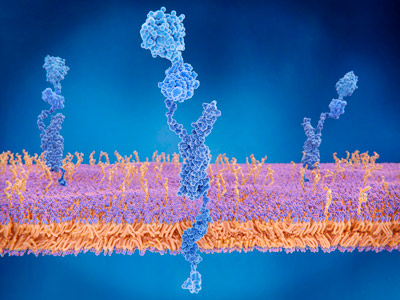Jul. 12, 2022 Research Highlight Biology
Mouse model to explore links between Alzheimer’s disease and vascular amyloid plaques
A new model mouse for the disease responsible for most cases of dementia also exhibits a common condition that accompanies Alzheimer’s in people
 Figure 1: An illustration depicting the amyloid precursor protein at a cell membrane. Shinobu Kitazume and her team produced mice that expressed the protein in their endothelial cells and then crossed them with a model mouse for Alzheimer’s disease. © JUAN GAERTNER/SCIENCE PHOTO LIBRARY
Figure 1: An illustration depicting the amyloid precursor protein at a cell membrane. Shinobu Kitazume and her team produced mice that expressed the protein in their endothelial cells and then crossed them with a model mouse for Alzheimer’s disease. © JUAN GAERTNER/SCIENCE PHOTO LIBRARY
For the first time, RIKEN biologists have produced a mouse that both approximates Alzheimer’s disease in humans and exhibits significant buildup of a peptide called amyloid beta in blood vessels in the brain, which often goes hand-in-hand with Alzheimer’s in humans1. This will help researchers to explore the connection between the two conditions.
Despite being the most common form of dementia, affecting tens of millions of people globally, and the focus of extensive research over decades, Alzheimer’s disease still lacks an effective treatment.
A plethora of genetically engineered mice with Alzheimer-like conditions has been developed to investigate the neurodegenerative disorder, but none of them perfectly reproduces Alzheimer’s in humans. In the past, several potential drugs showed a lot of promise in mice only to flop when they underwent clinical trials in human patients.
Mouse models produced to date exhibit very little buildup of amyloid beta in blood vessels in the brain—a common occurrence in people with Alzheimer’s, often the buildup starting decades before symptoms appear. This has made it difficult to explore the connection between Alzheimer’s disease and the deposition of amyloid beta in the blood vessels of the brain.
“Vascular amyloid deposition is a key pathology for Alzheimer’s disease, with most patients exhibiting it,” says Shinobu Kitazume from the RIKEN Center for Brain Science. “But most Alzheimer’s model mice show very limited vascular amyloid deposition.”
 Yuriko Tachida (left), Shinobu Kitazume (right) and co-workers have produced a mouse model for Alzheimer’s disease that also exhibits cerebral amyloid angiopathy.© 2022 RIKEN
Yuriko Tachida (left), Shinobu Kitazume (right) and co-workers have produced a mouse model for Alzheimer’s disease that also exhibits cerebral amyloid angiopathy.© 2022 RIKEN
Now, Kitazume, who is also at the Fukushima Medical University School of Medicine, and her co-workers have succeeded in producing a model mouse for Alzheimer’s that has significant amyloid beta accumulation in the brain blood vessels.
Kitazume, who is a biochemist by background, discovered that mice and rats had much lower levels of the soluble precursor protein for amyloid in their bloodstream than humans. She speculated that was because their endothelial cells—cells that line blood vessels—produced low levels of the precursor. Yuriko Tachida in Kitazume’s team then produced mice that expressed the human version of the amyloid precursor protein in their endothelial cells. When they crossed these mice with conventional Alzheimer model mice produced by colleagues at RIKEN, the resulting mice exhibited both Alzheimer-like characteristics and high amyloid beta deposition in their brain blood vessels.
Kitazume sees a lot of potential to use the mice to both explore the buildup of amyloid beta in brain blood vessels as well as how it interacts with Alzheimer’s disease. “There are several interesting ways to use these mice,” says Kitazume. “And already several pharmaceutical companies have expressed interest in using them.”
Related contents
- New mouse model mimics earliest stages of Alzheimer’s disease
- Missing link in late-onset Alzheimer’s disease
Rate this article
Reference
- 1. Tachida, Y., Miura, S., Muto, Y., Takuwa, H., Sahara, N., Shindo, A., Matsuba, Y., Saito, T., Taniguchi, N., Kawaguchi, Y. et al. Endothelial expression of human amyloid precursor protein leads to amyloid β in the blood and induces cerebral amyloid angiopathy in knock-in mice. Journal of Biological Chemistry 298 101880 (2022). doi: 10.1016/j.jbc.2022.101880
